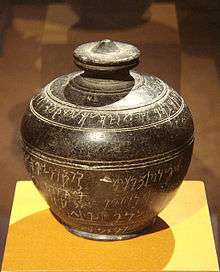Vispavarma
Vispavarma or Visnuvarma (ruled circa 0-20 CE)[2] was an Indo-Scythian king of the Apracas, who ruled in the area of Bajaur in modern northwestern Pakistan. His reign is known for sure to include the date of 6 CE, due to his description as king on the 5-6 CE Bajaur casket.[3]

Vispavarma is mainly known from a dedicatory Buddhist inscription by his son Indravarma, who mentions him as his father. The inscription which is written in Kharoshthi, translates into English as:
Prince Indravarma, son of Commander Vispavarma, together with his wife establishes these bodily relics in his own stupa. Commander Vispavarma and Sisirena, the wife of the Commander, are (hereby) honored. Indravasu, king of Apraca, and his wife Vasumitra, who is the mother of a living son, are (hereby) honored
In the Bajaur casket inscription, Vispavarma is further described as king of the Apracas by his son Indravarma, the date of the dedication being 5-6 CE:
In the sixty third year of the late great king Aya (Azes), on the sixteenth day of the month of Kartia (Kartika), at this auspicious (?) time, Prince Indravarma (Indravarman), son of the king of Apraca, establishes these bodily relics of Lord Sakyamuni; …. He produces brahma-merit together with his mother, Rukhunaka, daughter of Aji…. And these bodily relics having been brought in possession from the Muraka cave stupa, were established in a secure (?), safe, deep (?), depository…
— Text of the Bajaur casket, Metropolitan Museum of Art.
Since the Bajaur casket indicates that Vispavarma was king as of 5-6 CE, his reign is usually dated to around 0-20 CE.
Notes
- Metropolitan Museum of Art notice
- A Kharosthī Reliquary Inscription of the Time of the Apraca Prince Visnuvarma, by Richard Salomon, South Asian Studies 11 1995, Pages 27–32, Published online: 09 Aug 2010
- An Inscribed Silver Buddhist Reliquary of the Time of King Kharaosta and Prince Indravarman, Richard Salomon, Journal of the American Oriental Society, Vol. 116, No. 3 (Jul. - Sep., 1996), pp. 441-442
- The World's Writing Systems, Peter T. Daniels, William Bright, Oxford University Press, 1996, p.382